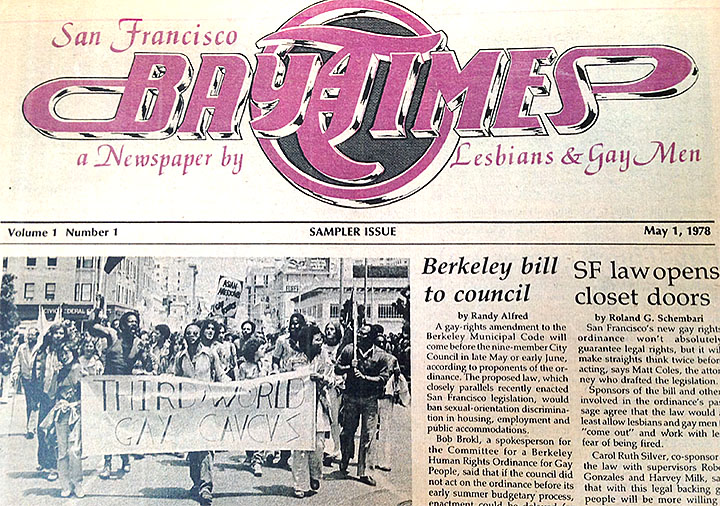From arts and culture to the AIDS epidemic to city politics, San Francisco’s gay, lesbian, bisexual and transgender press has delivered entertainment, opinion and crucial information to Bay Area residents since the early 1970s.
By Jennah Feeley
Protests, parades, riots and rallies characterized San Francisco’s Castro District from the late 1960s through the 1980s. The election of the first openly gay supervisor, Harvey Milk, in 1977, and the enormous strides the gay rights movement took toward achieving equality were primary interests of the community during those turbulent times.
San Francisco became the national epicenter of LGBT activism in the 1970s. Gay men and women flocked to the city and the increasing population required more specific media coverage to cater to their needs. LGBT publications were soon created.
LGBT-focused news coverage began with the Bay Area Reporter—or BAR as most readers call it. Founded by Bob Ross and Paul Bentley in April 1971, it was reportedly delivered to local bars by way of Ross’ 1969 Ford Mustang during the early years. The Bay Area Reporter upholds its relevance in the LGBT community today.
“We’re the oldest continuously published and highest circulation LGBT newspaper in the country,” said Roberto Friedman, arts and culture editor since 1998. “We have a very well-regarded arts section. And we’ve added a nightlife section, BARtab.”
BAR, in its earliest days, was a critical resource for San Francisco’s gay community. With social rights protests, an increased LGBT political presence and the AIDS epidemic, the newspaper had its beats solidly defined.
The San Francisco Sentinel was the city’s first widely circulated publication created to meet the needs of gay men and women in the city. Activist Charles “Chuck” Lee Morris first published the Sentinel in 1974.
Randall H. Alfred was hired as news editor in 1975 and wrote the column entitled “Waves from the Left.” He later became editor in chief of the Sentinel in 1982 – a year after William Beardemphl purchased the paper.
The campaign and election of San Francisco Supervisor Harvey Milk in 1977, his inauguration in 1978 and the slaying of Milk and Mayor George Moscone that same year dominated news coverage by the LGBT press and mainstream media.
Beardemphl, in the early 1980s, believed AIDS was being blamed on the gay community to simply rain on its parade. He published an April Fool’s Day article, in 1982, entitled “Gay Cancer Caused By Brunch.” The paper was condemned by its readers for trivializing the disease.
The San Francisco Sentinel shut down in 1995 after 21 years of publication. Then-owner Ray Chalker had struggled to keep the paper going alongside his other business interests but couldn’t weather the financial strain.
By the 1980s the Castro had been established as the unofficial “Gay Mecca” of the world and AIDS had reached epidemic proportions. Many relied on the Bay Area’s LGBT press to provide information about the new, seemingly gay-centric disease.
The Bay Area Reporter became a weekly publication in the 1980s, largely for purpose of disseminating information about HIV and AIDS. The disease devastated the community and BAR helped educate its readers. With each passing week, victims of AIDS were remembered in BAR obituaries.
HIV treatments became more effective and available in the late 1980s and publications like the BAR were delivering vital information to discourage the spread of HIV. The paper’s famous “No Obits” headline in 1988 brought readers hope, marking the first edition since the epidemic began that was not overshadowed by AIDS-related deaths in the community.
The San Francisco Bay Times was the first newspaper in the city entirely owned and funded by LGBT men and women. First published in 1978, the San Francisco Bay Times also emerged.
The initial team included associate editor Roland Schembari, general manager Bill Hartman, features and opinion editor Priscilla Alexander, arts and entertainment editor M.J. Lallo and news editor Randall (Randy) H. Alfred. Kim Corsaro became publisher in 1981, a position she held until 2011.
The publication was a soapbox for notable figures. The Bay Times gave voice to Phyllis Lyon, co-founder of the first national lesbian organization in the U.S., and Cleve Jones of the NAMES project, which developed the AIDS Memorial Quilt. Both were early contributors.
Coverage of Harvey Milk’s assassination and ongoing legacy made headlines during the Bay Times’ early years. The paper was later published under the name Coming Up for nearly a decade and focused primarily on cultural and political happenings in the LGBT community.
The original name, San Francisco Bay Times, was reinstated in 1988 and the “Personals” section gave the paper a more significant presence within the community. Today the Bay Times is co-published and co-edited by Jennifer Viegas and Betty Sullivan, Ph.D., a respected academic and communicator.
Coverage has evolved since the creation of the publication, but Sullivan works to provide for today’s readers.
“The need for human connection is timeless and so long as the San Francisco Bay Times facilitates and promotes beneficial connections it will remain a vital force within our community,” she said.
Other print and online publications that have emerged to serve San Francisco’s gay community include:
• The Castro Courier: Founded by Andy Sywak in 2007, the Castro Courier is a free monthly newspaper for the Castro and neighboring communities.
• Mycastro.com: Anthony G. Rodriguez founded the website as a community resource for readers to connect, utilize business and restaurant listings, and stay informed with the latest news in the Castro.
• The Castro Biscuit: This blog serves the Castro community. Roy McKenzie is the founder and managing editor.
♦
Jennah Feeley is a Northern California Media Museum writer majoring in journalism at San Francisco State. A Palo Alto native, she also works for a San Francisco startup in the Mission District.

